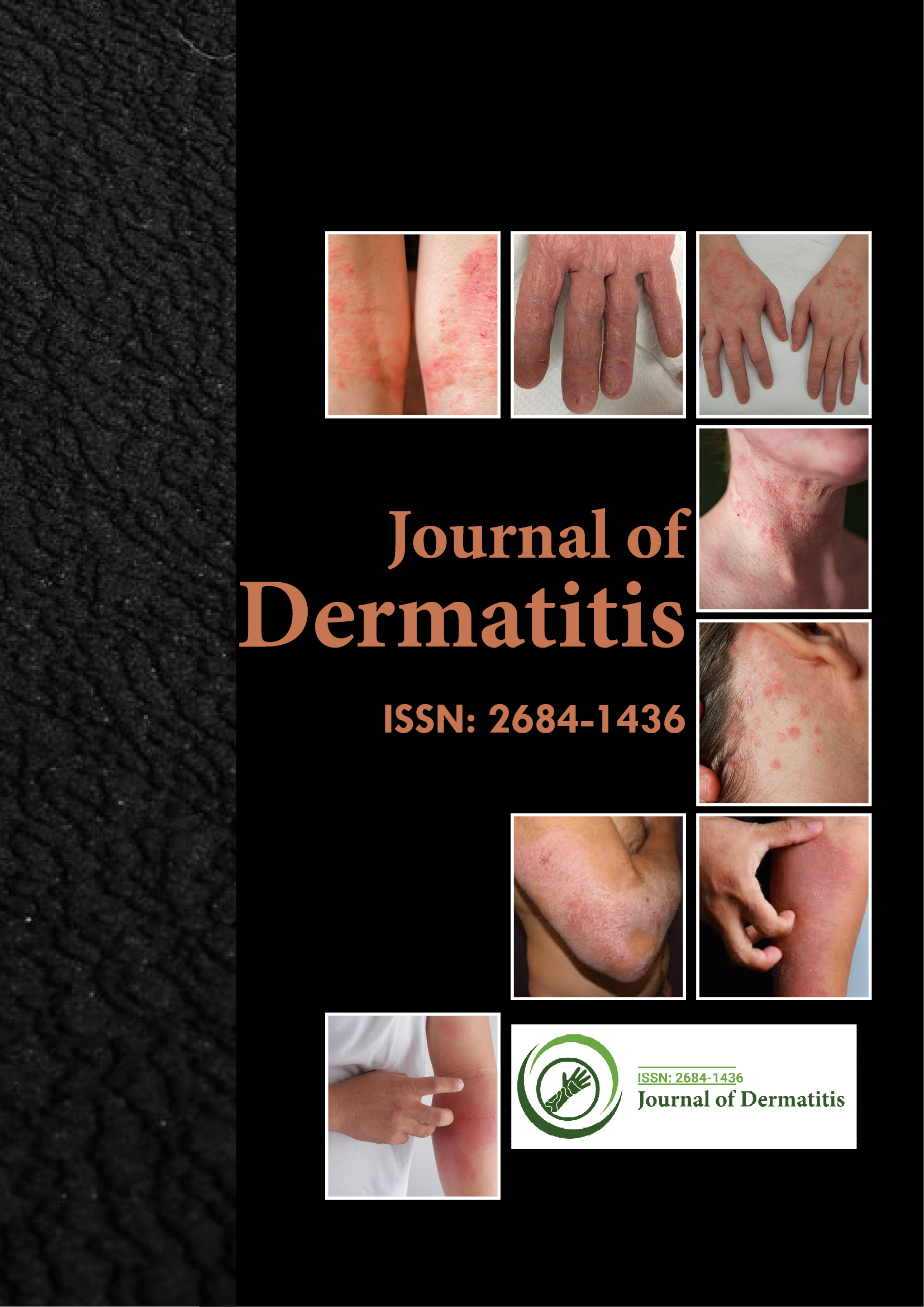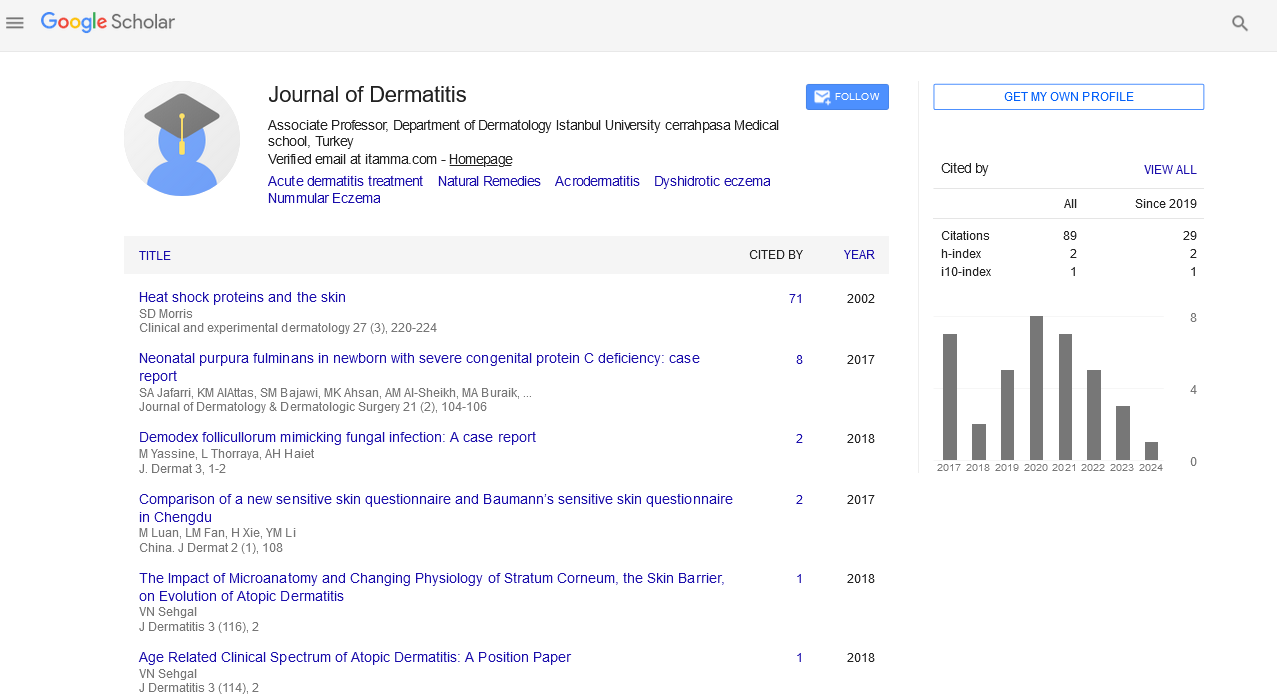Indexed In
- RefSeek
- Hamdard University
- EBSCO A-Z
- Euro Pub
- Google Scholar
Useful Links
Share This Page
Journal Flyer

Open Access Journals
- Agri and Aquaculture
- Biochemistry
- Bioinformatics & Systems Biology
- Business & Management
- Chemistry
- Clinical Sciences
- Engineering
- Food & Nutrition
- General Science
- Genetics & Molecular Biology
- Immunology & Microbiology
- Medical Sciences
- Neuroscience & Psychology
- Nursing & Health Care
- Pharmaceutical Sciences
Commentary - (2024) Volume 9, Issue 1
Understanding Skin Redness: Causes and Treatment
Tanusuko Matum*Received: 02-Mar-2024, Manuscript No. JOD-24-26011; Editor assigned: 05-Mar-2024, Pre QC No. JOD-24-26011 (PQ); Reviewed: 21-Mar-2024, QC No. JOD-24-26011; Revised: 27-Mar-2024, Manuscript No. JOD-24-26011 (R); Published: 05-Apr-2024, DOI: 10.35248/2684-1436.24.9.228
Description
Skin rashes and inflammation, which can cause redness, pain, itching, and dryness, can be challenging to diagnose and treat. Among the common inflammatory skin disorders are dermatitis, drug rashes, poison ivy, and poison oak. Doctors typically divide skin conditions into four categories: Acute dermatitis, non-acute dermatitis, chronic dermatitis, and acute alopecia. Acute dermatitis is a frequent skin condition that develops after a minor burn, cut, or scrape. Acute skin inflammation causes normal skin tissues to seem inflamed. Normal skin tissues appear normal during the healing phase and maintain their normal appearance in the ensuing months of non-inflammatory conditions. Conversely, skin inflammation can cause thickening, redness, edema, itching, and discoloration. Skin inflammation can range from severe to persistent.
A chronic skin condition can arise from persistent inflammation of the skin. When the skin becomes suddenly irritated due to an injury or sickness, this is known as acute skin inflammation. Individuals with inflammatory skin conditions often need to take preventative measures to avoid issues like infection or chronic skin redness and irritation. It is important to see a doctor as soon as possible for a skin examination if there is persistent skin inflammation.
Skin redness can result from a variety of conditions besides infections and rashes. Skin redness, for instance, may also result from a skin lesion brought on by an infection or another skin condition. A skin lesion is a skin condition that consists of a wound brought on by another skin disorder or an injury. A skin rash, irritation, swelling, redness, discoloration, or infection may be connected to the skin lesion. Skin sores brought on by contagious illnesses like herpes can occasionally be invisible. Anyone experiencing an intense skin rash should seek medical assistance.
They should visit a doctor right away if they discover any new symptoms or a skin reaction after receiving therapy for a skin problem, even if the rash is not severe and doesn't need to be treated. When a patient has persistent dermatitis or a similar illness, skin redness is frequently the first symptom they detect. Firstly, the redness of the skin that is linked to persistent dermatitis is referred to by some medical professionals as erythema vasculitis or sebaceous hyperpigmentation. It is also known as erythema vasculitis, rash, skin inflammation, or skin redness. Tetracycline is a topical medication that some patients use to treat their chronic skin rash. Nonetheless, receiving medical attention is required in specific circumstances. Skin redness might be lessened or completely gone with therapy. When using steroids, antibiotics, or steroid creams or ointments containing corticosteroids are applied by medical professionals to lessen inflammation, the redness of the skin can be minimized or completely.
Drug therapy is an option for treating skin redness in the event that treatment is unsuccessful. In order to address the redness resulting from skin inflammation, a physician may recommend topical corticosteroids, oral corticosteroids, or antibiotics. Antihistamines are also frequently used to address inflammation of the skin. For instance, oral or prescription antihistamines are advised to relieve skin redness brought on by poison ivy. When it comes to treating poison ivy-related skin redness, antihistamine medication typically works well; however, it may not always work for other kinds of skin redness. A topical steroid may also be prescribed by a physician to address skin redness brought on by eczema or psoriasis.
A doctor may prescribe topical and oral medications to treat skin inflammation related to skin diseases in order to lessen accompanying redness and itching. For instance, topical steroids or steroid ointments that lessen redness and irritation are frequently used to treat skin inflammation. Another treatment for skin redness brought on by skin conditions including psoriasis and skin inflammation is an ointment that contains corticosteroids. Skin redness brought on by medical disorders, on the other hand, may be more challenging to treat and may persist in its red, inflammatory state even after treatment is completed. Skin care professionals occasionally recommend systemic medications that are taken orally to relieve skin redness.
Citation: Matum T (2024) Understanding Skin Redness: Causes and Treatment. J Dermatitis. 9:228.
Copyright: © 2024 Matum T. This is an open-access article distributed under the terms of the Creative Commons Attribution License, which permits unrestricted use, distribution, and reproduction in any medium, provided the original author and source are credited.

